

Reproductive system, procreation, penis, vagina, sperm, ova, egg, prostate, testicles, testes, sexual intercourse, fallopian tubes, ovaries, uterus, cervix, pregnancy, corpus luteum.
Humans need to procreate in order for the survival of the species. As with other species, this is a given. For us to be able to do that, we need a reproductive system. We know that we have male and female genders, and these each have their own components.
The male reproductive system comprises of:
Externally, all you can see of the male reproductive system is the penis and the testes (encased in a scrotum - commonly called the ball bag). This enters the vagina, in what is known as penetrative sexual intercourse.
When a man climaxes, he exerts sperm from the testes, through the urethra and out the end of the penis. This then enters the vagina. For the man, this is biologically all he has to do to reproduce.

In the animal kingdom, to mate, an octopus will literally rip its penis off, throw it at the female, and grow a new penis. The octopus can also regenerate all it's tentacles if they are cut off.
Let's take a look at the roles of the male reproductive organs:
Sperm: the sperm is what is exerted from the penis upon climax during intercourse. This is a single-cell gamete that finds the ova in the female reproductive system.
Testes: these are what store and create the sperm. There is more on what sperm does in the DNA and Cells section of the website. The testes also creates testosterone, a hormone that allows the man to enter puberty and grow masculine features such as pubic hair, facial hair and gives them a change in voice.
The penis: this is an intromittentAllows for insertion into the vagina. organ that allows for sexual intercourse. It also acts as the urinal duct for a male.
The prostate: a gland that produces seminal fluid that mixes with sperm to make semen. Testosterone controls how the prostate works.
The following still is from a video on the male reproductive system, with the following details:
Please click on the image to view the video.
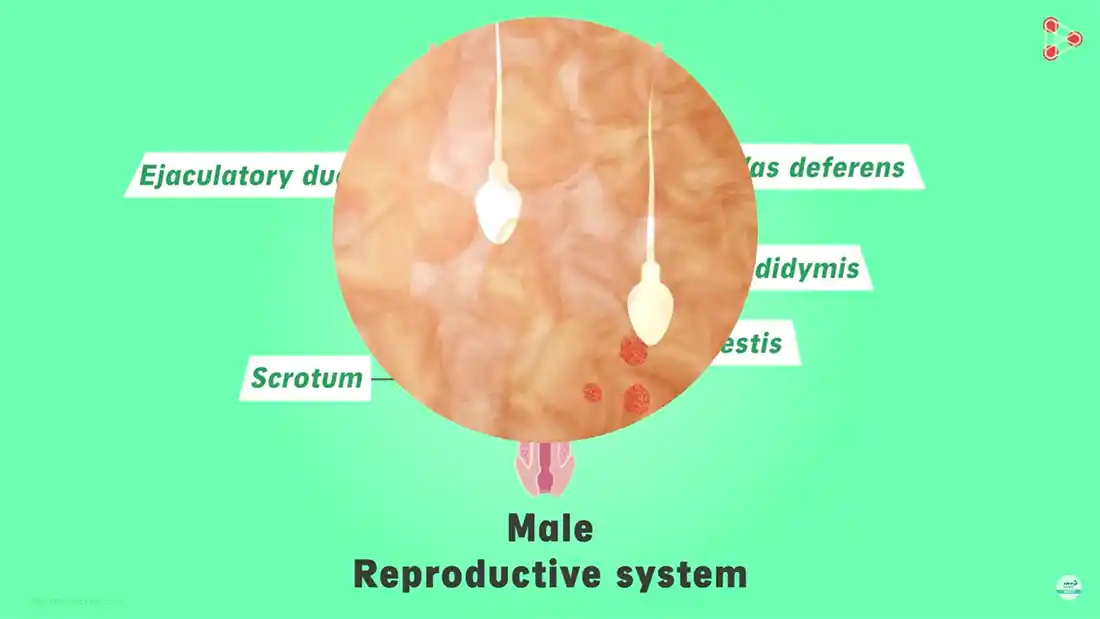
Females have a more complex system than the males, as they hold the embryo and foetus during pregnancy, and give birth. It comprises of:
Let's take a look at the female reproductive organs:
Vagina: everyone knows this one, and it's the first point of insertion for the penis upon penetration. It is a muscular canal lined with mucus and nerves. It links the outside of the body with the uterus and cervix.
Cervix: a small cavity that links the vagina to the uterus, the cervix houses small hairlike structures called cilia that move the sperm along and further up the uterus to help with fertilisation.
Uterus: also called the womb, the uterus is where a foetus and baby will develop in the three trimesters that it is housed for. It is lined with endometrium, a thick, moist mucus membrane that protects the baby while in the womb. This is also what is ejected from the body during menstruation.
Ovaries: the female reproductive system has two ovaries, and they are connected to the uterus by the oviducts (explained below). The ovaries keep the eggs until ready to release. The eggs are already there, and are there during a mother's pregnancy. It is here that the corpus luteum, named after the Latin name of saffron-yellow, luteus. It enables the production of oestrogen and progesterone. These hormones allow for the change in the uterus to enable fertilisation. If no fertilisation happens, menstruation occurs instead.
Oviducts/Fallopian Tubes: the oviducts, also known as fallopian tubes, are small transport tubes that connect the uterus and ovaries. They allow transport of sperm to the egg, and enable fertilisation.
In similar fashion to the male system, the female system also has a climax, and will exert fluid during climax. Once the sperm has entered the female reproductive system, they will travel up to the cervixThe lower part of the vagina.. A male can ejaculate up to 200 million sperm each time, but only around 2 million sperm will reach the cervix, as they have to flow through acidic fluid inside the vagina.
The sperm then have to find their way up to the top of the organ, the uterusThe upper area of the vagina., and only around 10,000 make it there. They are continually attacked by white blood cells and absorbed by the phagocyteA white blood cell of the immune system..
By the time they reach the fallopian tubes, there are now just 5,000 sperm left. They have travelled up through the vagina, the cervix, the uterus and now they face their biggest challenge - attaching to the egg. All along the fallopian tube, sperm will have either petered out and given up, or will find themselves attached to the tube itself, as it is covered with a layer of mucus.
So, while all of this happens, each interaction with sperm is undertaken with the white blood cells, and a woman's immune system to fight off infection.
The following still is from a video on the female reproductive system, with the following details:
Please click on the image to view the video.
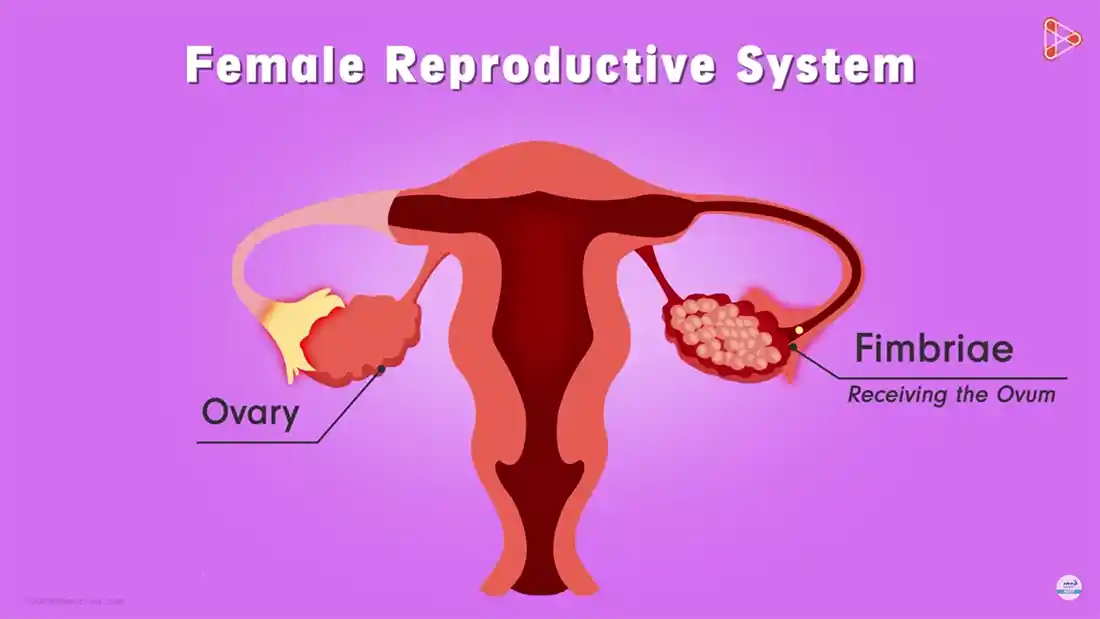
Well, this is where the one egg, and the one sperm form an embryo and in a few weeks' time, it will be a foetus, which by that point, it will be considered a baby, and the female is pregnant.
It takes 9 monthsThe longest known pregnancy lasted for 375 days, in 1945. to conceive and go a full term in pregnancy. In this time, the baby develops in the womb (uterus), and then when ready, the vagina will dilate to up to 10cm, and allow for passage of the new born baby.
The foetus needs nourishment and time to develop. It also needs other components in order to start growing, such as:

The umbilical cord has 2 arteries and 1 vein, linking the mum with the baby. The vein transports oxygen and nutrients to the baby, and the arteries remove waste material via the mother's kidneys. It also holds stem cells which can differentiate into different types of cells.
The reproductive system uses two specialised cells that work to create new life. They interact with each other when two people have sex, and can be controlled using contraceptives. The specialised cells are called gametes, which are unique in the fact that they only have one set of chromosome within them. They are as follows:
Sperm: one of the two types of gamete in our body, a male will produce a sperm cell. These are tiny cells that when released into a woman's vagina, fight their way up to an ova, or egg.
Ova (Egg): the egg cell is situated in the woman's reproductive system, and once joined with a sperm cell, allows for the creation of a baby. A woman will have all the eggs she needs to reproduce before she is even born, as during the foetal stage of pregnancy, all the eggs are created then.
If you are unable to see the board, please click here.
Menstrual cycle, menstruation, period, ovulation, reproduction system, uterus lining, follicle stimulating hormone (FSH), lutenising hormone (LH), oestrogen, progesterone, pituitary gland, ovaries.
Once a month (sometimes earlier, sometimes later) a woman goes through a period. This is part of a whole cycle over the course of a month where a woman's body changes for reproduction.
Be ready for some graphic details here. At least, you may find them unsettling. But they are a natural process, so it needs to be discussed.
OK, so we start at the beginning. And the beginning is when a woman first starts to discharge blood from their uterus. The reason for this is because before menstruation, the lining of the uterus is prepared for pregnancy. Menstruation occurs because there is no pregnancy going forward, so this results in the lining being shed.
The process of the uterus lining being shed lasts for around 7 days. Sometimes this can vary, and it can fluctuate between 5 and 10 days, depending on the woman, as every woman's body is different.
The following still is from a video on menstruation, with the following details:
Please click on the image to view the video.
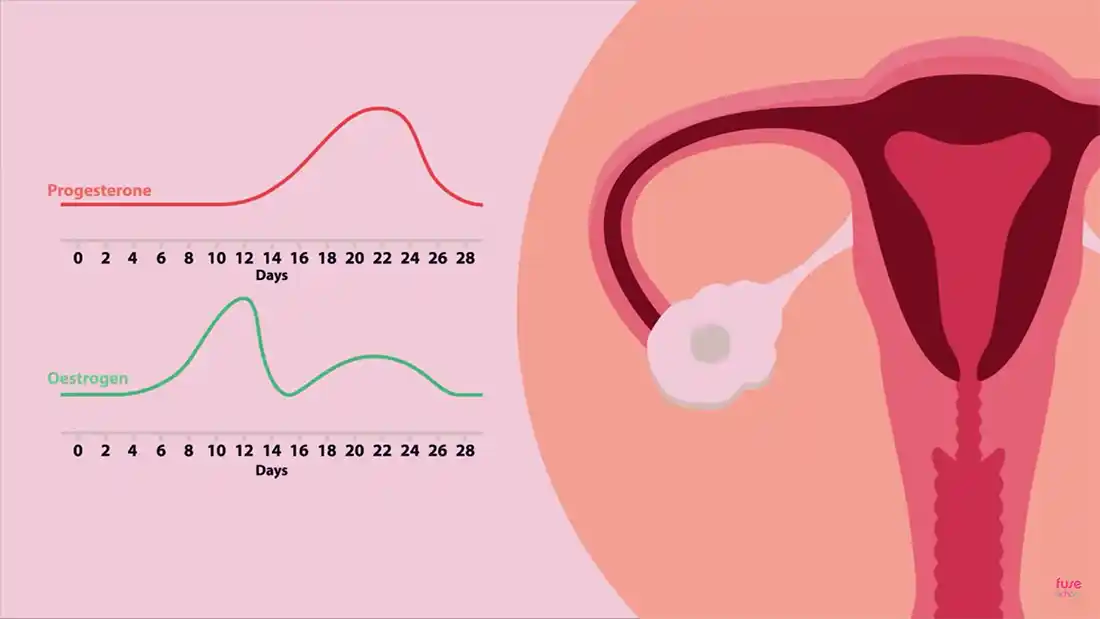
There are four hormones that help with menstruation:

A female's first period is called a menarche. This is taken from Greek: men = month, arkhe = beginning. Once the menarche has occurred, a female will not start to ovulate until between a year and 18 months after this.
Two hormones, FSH and LH, are created in the pituitary gland. The other two, oestrogen and progesterone, are created in the ovaries.
If a woman falls pregnant, the placenta creates the hormone progesterone, as it needs a lot of this to maintain the uterus.
The entire process of menstruation begins on the first day of the uterus shedding the lining, until the day before the next cycle begins.
When the follicles in a woman's ovary become dominant, and they are ready to release an egg, what's left behind changes. It falls in on itself, and releases a different hormone to what it was doing during incubation of the egg. This is what is known as the corpus luteum.
But what does it do?
Well, actually, it's a gland structure that remains only temporarily. I said it changes the hormone it releases when the egg is free; that is changed to oestrogen and progesterone. They release these hormones to aid the body in preparation for conception. They build up the lining in the uterus and help to maintain that lining if conception is successful.
When the corpus luteum breaks down, it leaves behind scar tissue in the form of cartilage. This is then called corpus albicans. It sticks to the ovaries for a while, before being destroyed by macrophages of the immune system.
Menstrual cycle over a 28 day period, image courtesy  YourFertility.
YourFertility.
Contraceptives, protection, copulation, condoms, pill, combined pill, cap, diaphragm, 21 days, implant, injection, patch, coil, vaginal ring, tubal ligation, vasectomy, semen, ejaculate, sperm, vagina.
A contraceptive is a way of protection during copulation. There are several ways you can have protective sexual intercourse. Let's have a look at some of the options.
For women, the easiest option is the pill. Marketed as the pull in the 1960s, it is literally a small pill taken daily to suppress the egg from ovulation.
The pill is taken every day for 21 days, and then a break of 7 days. This is to allow for the woman to have a period.
The pill is over 99% effective at its job, and it means that as few as 1 in 100 who use it will fall pregnant. This is all stated either by the doctor, or on the packaging of the tablets.
Condoms are the men's main go to for protection during sex. They are also available for women, in the form of female condoms. These go inside the vagina, whereas a male condom goes on the penis.
The condom is the only contraceptive that is able to protect from pregnancy and STIsA Sexually Transmitted Infection.. They are made from very thin latex rubber, polyisoprene and polyurethane. There are different types for the reason of allergies (mainly to latex).

The first national rollout of contraceptives in a country was in India in 1952. This included a shift from a calendar based method of contraception, to sterilisation and IUDs (a device like a coil).
The following still is from a video on contraceptives, with the following details:
Please click on the image to view the video.
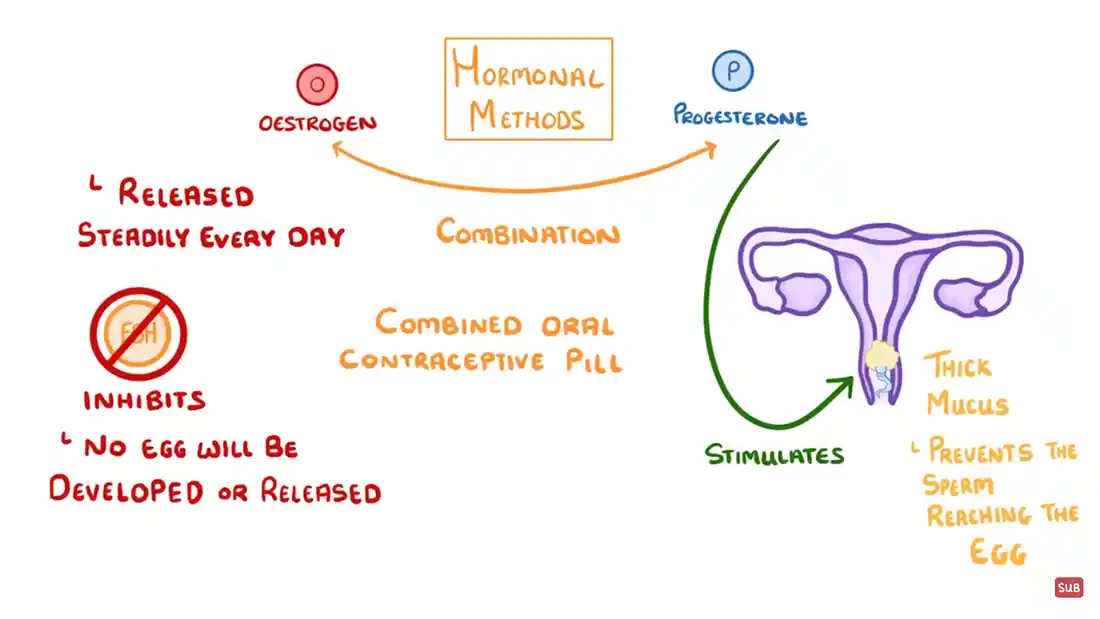
There are other methods of contraception to consider. They include:
There are two more types of contraception, but these are a permanent fixture:
Pregnancy, 9 months, trimester, 39 weeks, embryo, foetus, baby, development, hearing, hormonal functions, Braxton Hicks, false contractions, uterus, 12-week scan, 20-week scan, discomforts.
Pregnancy in humans usually occurs over a period of 9 months. This is also usually measured in weeks (which is 39 weeks), and most pregnancies deliver between 36 and 40 weeks.
The whole term is split into three parts - called trimesters. Let's have a closer look.
You should know by now how a baby is conceived, so I'm going to start from just after then. This is the first month of pregnancy.
It does actually start from conception. For this example, we will use the names James and Lily. James and Lily have just had unprotected sex at peak time of ovulation to have maximum chance of pregnancy. This is usually 12-14 days after a period.
The chance paid off, as Lily is now pregnant. This is the first month, remember, so forming inside her is nothing more than two cells - the sperm and egg that have fused together.
As early as 4-5 weeks, in month two, the baby's brain forms, and the heart starts beating. Inside the uterus, also known as the womb, the walls are continually being strengthened to hold the baby and help nurture it.
As for Lily, well she will be starting to feel fatigue, frequenting the toilet more often, possible morning sickness (I will just say, this isn't always true, as my wife did not have any sickness with our child, and also it can be in the evening instead of the morning) and changes to hormonal functions. At this time, the baby is called an embryo, and is still not a formed human.
Eight to twelve weeks, and we can officially say that Lily is carrying a baby. It is called a foetus, and is as big as a plum. So, not very big at all. Find a plum, put it in your hand, see how big or small it is. Very fragile.
Morning sickness for Lily will now reduce, and hormones will calm down a little bit as well.
At 12 weeks, Lily can go and have a first scan of the baby.

The oldest known woman to be pregnant and give birth was a Spanish lady called Carmela Bousada. She was 66 years old, and gave birth to twins via C-section. She died three years later from cancer.
This is the start of the second trimester. James and Lily's baby is now the size of an orange. It will weigh around 5 ounces.
The bones in the foetus will now start to harden and they can be seen using x-rays.
The following still is from a video on stages of pregnancy, with the following details:
Please click on the image to view the video.
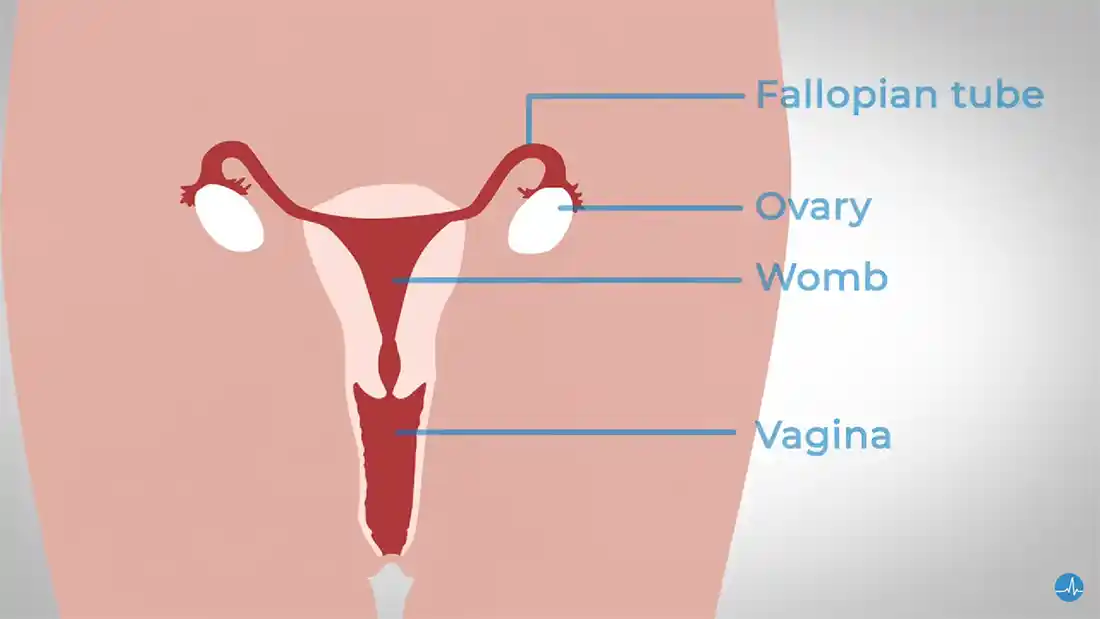
By month five, Lily can safely say she's having a baby. It is no longer a foetus, and is about the size of a small melon (Galia or Cantaloupe).
In this month, the baby will start to develop hearing, and should start to kick. Lily will have some common discomforts this month: backaches, indigestion, heartburn, headaches, water retention, dizziness and constipation. Any of them, maybe not all of them. Possibly none of them (lucky you!)
At 2o weeks, you will have your second scan for the baby, and you get the option to find out the sex of the baby, as it should be visible.
It's now halfway through Lily's pregnancy, and she will be pleased to know that her baby is almost fully formed. But she still has three months left to go.
Babies have been born at 24 weeks, and survived. Especially with today's modern technology. A baby will be very premature, and will most likely be incubated until necessary to make a full development possible.
At around seven months, Lily will begin to experience Braxton Hicks, or false contractions.
As for the baby (let's have a boy), he will be around 13 inches long now, and he will also be able to process sights and sounds within the womb, so will be able to react to voices.
Almost on the home straight now. Lily has put up with a lot as her body has changed significantly to house a small human being.
The boy is doing well, and is now almost fully formed, putting on weight. He will also be completing development of his lungs. A baby can be safely born at this point with no real complications.
By now, Lily is getting fed up having the boy inside, and will experience Braxton Hicks again, as well as trouble sleeping. There will also be pressure on the pelvic muscles, due to the boy's weight.
At 36 weeks (or up to two weeks either side), the baby will be born. If all goes well, the mother should give birth naturally. This means the vagina will dilate. By this, I mean it will become very wet, and stretch to 10cm (100mm) in order to push the baby out.
And now, James and Lily have their baby, Harry.
And yes, I did quote names from Harry Potter as an example. You're welcome.
Stages of a baby's development during pregnancy, image courtesy  Urban Mamaz
Urban Mamaz
Infertility, In Vitro Fertilisation (IVF), treatment, ovulation, hysterectomy, falling pregnant, endometriosis, operations, surgery, polycystic ovary syndrome.
When a couple decide to have a baby, usually the woman will come off the combined menstrual pill, and the man will stop using a condom, and they will copulate until they fall pregnant. Eighty-four percent of people will do this naturally, but the other 16% will have issues. These are issues that are called infertility.
Infertility can be for a number of reasons. When a couple have been trying for a baby for over a year, or for longer, their chances of falling pregnant become smaller, and the window of opportunity closes. There are a number of reasons, including:
There are other reasons for infertility. They include age, weight, STIs (Sexually Transmitted Infections), smoking, alcohol, stress, and environmental factors. Your health (in both male and female) is also an important factor with infertility. Without optimum health, your body may not produce the right amount/fertile enough sperm (male), and your uterus may not be in the right condition ready for fertilisation (female).
The following still is from a video on infertility, with the following details:
Please click on the image to view the video.
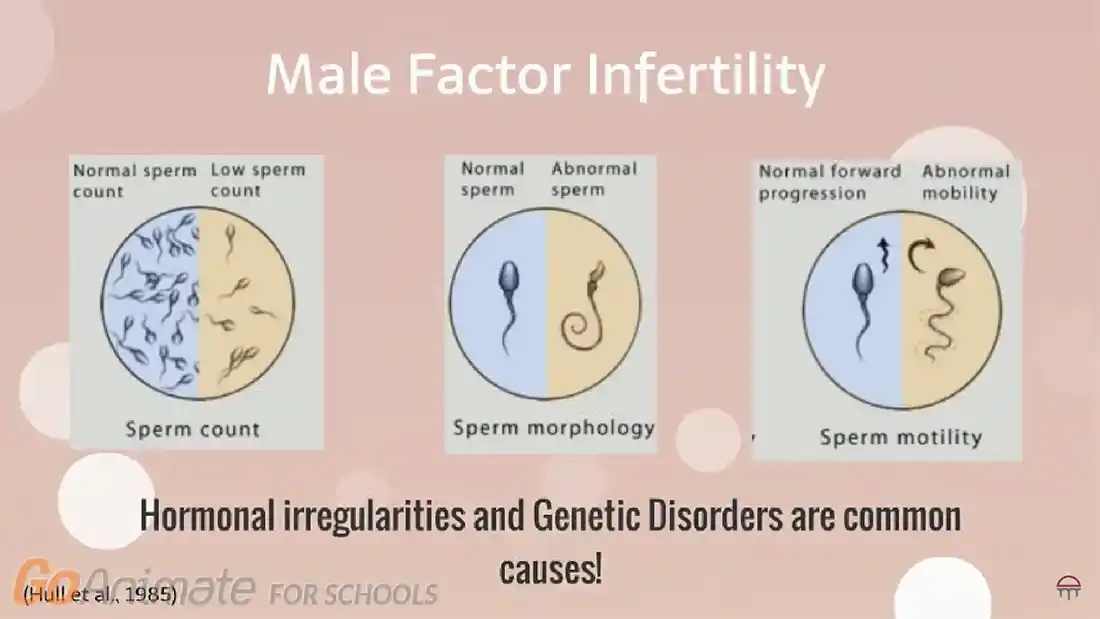

Despite most people thinking that infertility can affect the female, the split is actually equal in men and women having issues, obviously for different reasons. Both can be treated, however the process will take longer to conceive.
A common condition that affects how a woman's ovaries work, polycystic ovary syndrome is a condition whereby the ovaries are surrounded by fluid-filled sacs that surround the eggs. It can also have other effects, such as too much androgen (male hormones), or irregular periods.
These fluid-filled sacs, or follicles, are harmless, but they are also juvenile sacs where the eggs develop. They are often unable to release the eggs within, which lessens the amount of eggs released for fertilisation. The condition can affect 1 in 10 women, and more than half of those women do not see or have any symptoms.
While Polycystic ovary syndrome has no cure, it can still be treated. For example, while weight can also be an issue with it, losing that weight could help or increase the chance of fertility.
Other treatments include medication to stop the excess hair growth that comes with the androgen increase. These medications can also help with irregular periods.
If medication does not help, surgical practices can be done, in the form of laparoscopic ovarian drilling (LOD). This involves using a laser or heat to destroy the excess tissue in the ovaries that produce the androgen.
This is a condition where tissues similar to the lining of the uterus start to grow outside the womb. It can affect women of any age, and is a long-term condition that can have significant impact on your life, but it can be treated.
There are many symptoms to endometriosis, and include:
There are ways to treat endometriosis, including:
Disclaimer | About Me | Sitemap
Website design by SyntaxHTML.



Blue icons adapted from icons courtesy of Smashicons.com